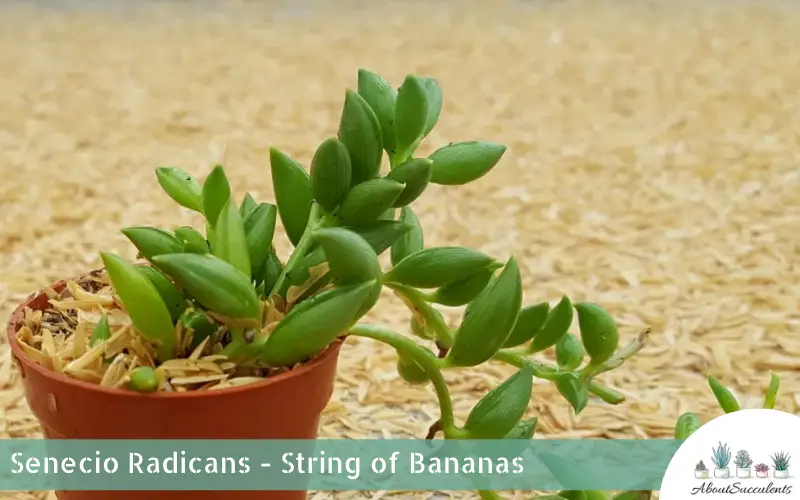
Senecio radicans are also called String of Bananas because its leaves are shaped like bananas. Senecio radicans is a fast-growing succulent that is often used as an ornament in a hanging basket or a tall planter which allows the stems to extend down to the floor like vines.
In South Africa, where String of Bananas originates, the succulent is used as ground covers along with other varieties of vegetation. The stems of Senecio radicans can reach 3-feet (90cm) long. The plant itself can reach a height of 2-feet or 61cm.
Senecio radicans produce small flowers that vary in color from white to yellow to lavender. The flowers emit a sweet and spicy scent that is reminiscent of cinnamon.
Senecio radicans comes from the Asteraceae family.
General Information:
Also known as: String of Bananas.
Plant Family: Asteraceae
Origin: South Africa
Height: 2-feet or 61cm
Exposure: Partial sunlight up to 6 hours
Water Needs: Frequent watering schedule during the summer months; very little to no watering in the winter or cold season.
Soil Type: Cactus soil mixed with perlite at a 2:1 ratio or cactus mix or potting soil with coarse sand at a 2:1 ratio.
Soil pH: Strongly Acidic (6.0 to 7.0 pH)
Tolerance: Drought; cannot tolerate frost
How to Grow Senecio Radicans
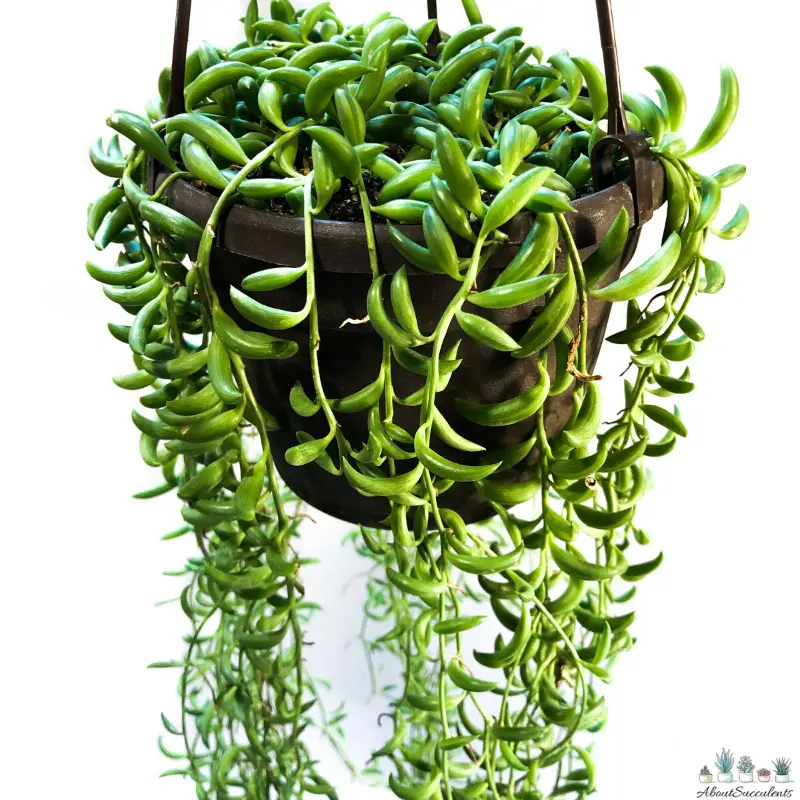
Senecio radicans is an easy succulent to grow and has become popular in recent years because of the cascading nature of its stems that make it a wonderful ornamental succulent.
String of Bananas is highly-resilient to dry weather but not intense heat. The succulent is also not frost tolerant. If the temperature in your region falls below 30° F or -1.1° C, it would be best to grow the Senecio radicans succulent indoors.
1. Sunlight
Senecio radicans thrives best when exposed to indirect sunlight. The succulent can get sunburned if exposed to intense heat or to direct sunlight for several hours. Generally, String of Bananas grows better when given 5 to 6 hours of indirect sun exposure.
If planted outdoors, place Senecio radicans in a partially shaded area or where it can receive cover from taller plants. The best location is one that receives a good amount of bright morning sun. Avoid places where it can get full exposure from the afternoon sun.
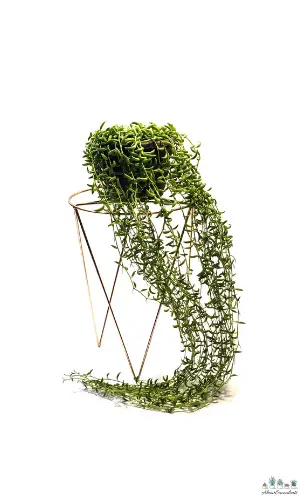
If grown indoors, place it near windows facing the east, south or west. Again, avoid direct sunlight. If the room receives poor sunlight, place the succulent under a Grow Light.
2. Watering
The stems of Senecio radicans and its plump banana-shaped leaves can store water which is the reason the succulent can endure prolonged dry climate.
Like other succulents, String of Bananas should only receive water when the soil is dry to the touch and free moisture. It is not uncommon for growers of this succulent to give it water every 7 to 10 days.
During wintertime, the soil stays moist longer which means you have to cut back on the watering schedule. You may only need to water Senecio radicans once a month in the wintertime. To be sure, check the topsoil’s level of dryness.
Overwatering the succulent will lead to root rot which can lead to fungal infection and possibly death.
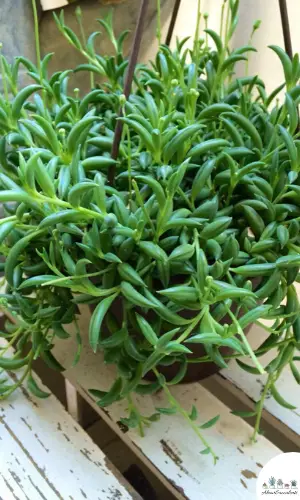
3. Pot and Soil
To minimize the risk of Senecio radicans getting root rot, plant it in a pot or planter that has good drainage.
The soil also needs to be well-draining. Cactus soil mix is a good choice for Senecio radicans. Add in perlite at a 2:1 ratio to further improve drainage. Another good option would be sandy soil which can be made by combining cactus mix or potting soil with coarse sand at a 2:1 ratio.
4. Fertilizer
Fertilizing will help ensure that Senecio radicans gets all the nutrients it needs to grow properly and produce its beautiful flowers.
Use a balanced blend of fertilizer that is diluted to half-strength. You can find fertilizer blends that are produced specifically for succulent plants.
Feed String of Bananas fertilizer during the active growing season which is the spring and summer months. Do not fertilize during the fall and winter seasons.
How to Propagate Senecio Radicans
Senecio radicans is a favorite for many succulent growers because it is easy to propagate. With a bit of patience and effort, you can have your patio adorned with many hanging planters of String of Bananas.
The only way to propagate Senecio radicans is by using its stem cuttings.
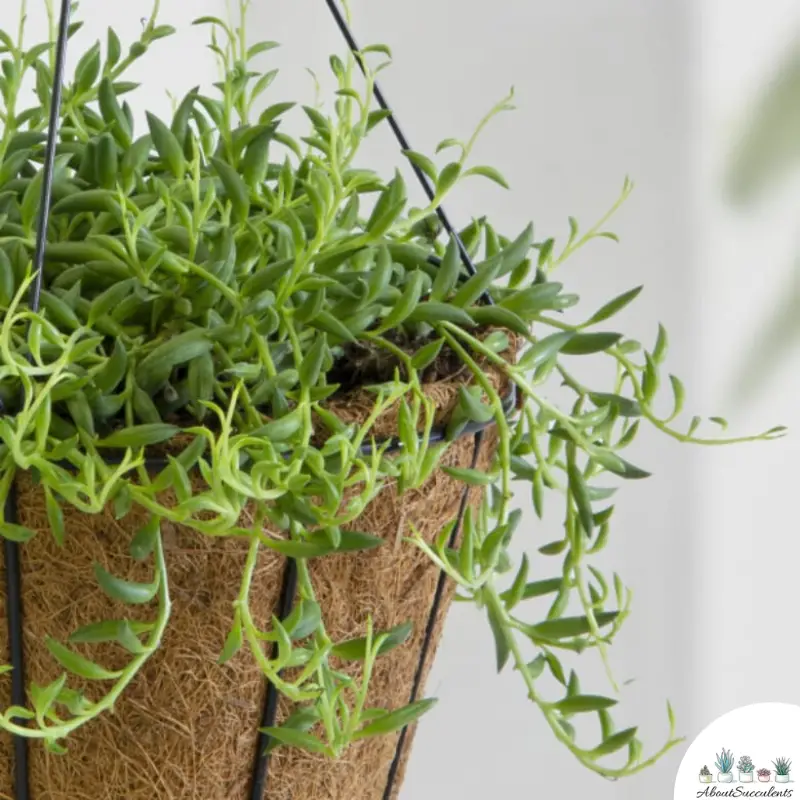
Step 1: Cut a mature stem for the best results. Make sure to use a sharpened and sterilized knife or garden shears when cutting off the stem.
Step 2: Unlike other succulents that require several days to dry out before planting, the stems of String of Bananas are so thin, it can dry out in 1 day. Simply leave the stem for up to a day and it should be ready for planting.
Step 3: Fill the pot with well-draining soil. You can choose to plant the cuttings in the soil or lay them on the soil. It will take 2 to 3 weeks for the plant to establish its roots.
Step 4: When the soil feels dry, give it a misting to ensure proper moisture. Once the roots have set in, switch from misting to watering.
Frequently Asked Questions
Is Senecio Radicans Toxic for Cats and Dogs?
Senecio Radicans does not appear in the American Society for the Prevention of Cruelty to Animal (ASPCA) website’s list of toxic plants which means it could be safe for your cats or dogs.
The list is not all-inclusive and only includes the plants that are frequently asked about. String of Bananas is closely related to another variety called String of Pearls which has been found to be mildly toxic to a few animals.
If your pet experiences gastrointestinal distress or vomiting when it comes in contact with String of Bananas, please consult with a veterinarian right away.
Why is my Senecio Radicans Succulent Dying?
String of Bananas is susceptible to 3 conditions: Overwatering, Underwatering, and exposure to intense heat.
1. Overwatering
Keep in mind that the plump, banana-shaped leaves of Senecio radicans functions to store water. If these leaves look mushy or burst to the touch, that means you are overwatering the succulent.
If the soil tends to stay moist longer, you can reduce the risk of overwatering by re-potting Senecio radicans.
2. Underwatering
If the leaves of Senecio radicans have the appearance of shrivelling up, this is a sign that of underwatering. You can restore the leaves to its normal plumpness by giving it enough water. Within 1 day, you should notice the leaves start to thicken again.
3. Exposure to Intense Heat
The leaves of Senecio radicans turn brown if they are exposed to extreme heat or direct exposure to the sun’s rays for several hours.
There is nothing you can do if the leaves are sun-damaged. You can only wait for the String of Bananas to produce new leaves and get rid of the damaged leaves.
Does Senecio Radicans Produce Flowers?
Senecio radicans produces small whitish flowers that may sometimes appear as lavender or yellow after 2 years.
Senecio radicans needs the ideal temperature to encourage its flowers to bloom. For outdoor growing, the ideal nighttime temperature should be around 50-55⁰F (10-13⁰C). For indoor growing, the ideal nighttime temperature is around 60-65⁰F(15-18⁰C).
Last Updated on June 12, 2022 by Sofia Lara